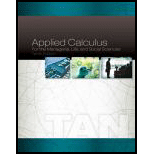
Applied Calculus for the Managerial, Life, and Social Sciences (MindTap Course List)
10th Edition
ISBN: 9781305657861
Author: Soo T. Tan
Publisher: Cengage Learning
expand_more
expand_more
format_list_bulleted
Concept explainers
Question
Chapter B, Problem 5E
To determine
To evaluate: The limit by using l’Hôpital’s Rule.
Expert Solution & Answer
Want to see the full answer?
Check out a sample textbook solution
Students have asked these similar questions
#32.
6. Determine the value of a such that lim
Va-x - V8+x
exists. Then determine the value of the
x-1
x-1
limit. Explain your thought process.
Use a graphing utility to find the indicated limit graphically. Answer 11-16.
Chapter B Solutions
Applied Calculus for the Managerial, Life, and Social Sciences (MindTap Course List)
Ch. B - Prob. 1ECh. B - Prob. 2ECh. B - Prob. 3ECh. B - Prob. 4ECh. B - Prob. 5ECh. B - Prob. 6ECh. B - Prob. 7ECh. B - Prob. 8ECh. B - Prob. 9ECh. B - Prob. 10E
Ch. B - Prob. 11ECh. B - Prob. 12ECh. B - Prob. 13ECh. B - Prob. 14ECh. B - Prob. 15ECh. B - Prob. 16ECh. B - Prob. 17ECh. B - Prob. 18ECh. B - Prob. 19ECh. B - Prob. 20ECh. B - Prob. 21ECh. B - Prob. 22ECh. B - Prob. 23ECh. B - Prob. 24ECh. B - Prob. 25ECh. B - Prob. 26ECh. B - Prob. 27ECh. B - Prob. 28ECh. B - Prob. 29ECh. B - Prob. 30ECh. B - Prob. 31ECh. B - Prob. 32ECh. B - Prob. 33ECh. B - Prob. 34E
Knowledge Booster
Learn more about
Need a deep-dive on the concept behind this application? Look no further. Learn more about this topic, calculus and related others by exploring similar questions and additional content below.Similar questions
- Evaluate 1. limit = 2. limit -3 3. limit does not exist 4. limit x + 1 lim x-1 x² – 3x − 4 - 5. limit 6. limit 2|5 1 5 20 5arrow_forwardDetermine 1. limit lim x →0 2. limit = 3 3. limit = 5. limit = 1 3 4. limit = -3 6. limit= - 1 2 2 1 3 3x 3 x² - -1/2)arrow_forward15. a) Find the limit. x²-9 lim x-3x²+2x-3 b)lim 25+h-5 harrow_forward
- Find the limits in Exercisearrow_forward3. What is the limit x+5 а. lim: х-2 х-4 x-4 b. lim x-4 x3-64arrow_forwardFor the function f graphed as follows, approximate each of the limits and values in Exercises 31–34: 3 1. + + -4 -3 -2/-1 1 2 4 -2- 31. lim f(x), lim f(x), lim_f(x), and f(-2). X-2- X-2+" X-2 32. lim f(x), lim f(x), lim f(x), and f(-1). x-1-* X-1+ X-1 33. lim f(x), lim f(x), lim f(x), and f(2). X2- x+2+ X+2 34. lim f(x), lim f(x), lim f(x), and lim f(x). x-00 3.arrow_forward
- In Exercises 87-89, use GRAPH and TRACE to find each limit. When necessary, state that the limit does not exist. x - 5 x2 - 4x - 5 find lim f(x) and lim f(x). 89. For f(x) X-1 Sx² – 2, for x < 0, 12 - x², for x 2 0, find lim f(x) and lim f(x). 87. For f(x) = Answers to Quick Checks X-2 1. (a) f(3) does not exist; (b) 6 2. (a) 1, 7, does not exist; (b) 3 3. (a) 3; (b) 3; (c) 3 4. (a) Limit does 20x2 88. For g(x) x + 2x2 + 5x find lim g(x) and lim g(x). not exist; (b) 5; (c) 6arrow_forward5. what is the basic concept of a limit? How is a limit calculated? What techniques / rules can be used to evaluate the limit of a function? What does the limit tells about the a function?arrow_forwardsolve the questions that have blue circle on it. solve using limit theorem (not graphically)arrow_forward
- 16. Let f(x) = x +3 if x -1 a) Evaluate the limit. If a limit does not exist, write DNE. lim f(x) i. lim f(x) I--1- b) Sketch the graph of f. ii. +1-+z iii. lim f(x)arrow_forward2. Use analytical techniques to find each limit (SOME justification other than a technology-produced graph must be shown). Vx-2 lim a. X3 x+1 Vx-2 b. lim X3+ 3-x Vx-2-1 c. lim X-3 x-3 x²-4x-5 d. lim x-1 x+1 x'-3x+2 lim е. x-5 3x-5x+2 f. lim 8-4x2 g. lim (33*) = lim (3*) (think about the first)arrow_forwardIn exercises 7 and 8, identify each limit or state that it does not exist. y -2 -2 7. (a) lim f(x)² -2 (b) lim f(x) (c) lim f(x) X→0- (d) lim f(x)z 2 (e) lim f (x) (f) lim f(x) X→-2- X→-2+ x→-2 (g) lim f(x) = DNE (h) lim f (x) x→-1 x→1-arrow_forward
arrow_back_ios
SEE MORE QUESTIONS
arrow_forward_ios
Recommended textbooks for you
 Calculus: Early TranscendentalsCalculusISBN:9781285741550Author:James StewartPublisher:Cengage Learning
Calculus: Early TranscendentalsCalculusISBN:9781285741550Author:James StewartPublisher:Cengage Learning Thomas' Calculus (14th Edition)CalculusISBN:9780134438986Author:Joel R. Hass, Christopher E. Heil, Maurice D. WeirPublisher:PEARSON
Thomas' Calculus (14th Edition)CalculusISBN:9780134438986Author:Joel R. Hass, Christopher E. Heil, Maurice D. WeirPublisher:PEARSON Calculus: Early Transcendentals (3rd Edition)CalculusISBN:9780134763644Author:William L. Briggs, Lyle Cochran, Bernard Gillett, Eric SchulzPublisher:PEARSON
Calculus: Early Transcendentals (3rd Edition)CalculusISBN:9780134763644Author:William L. Briggs, Lyle Cochran, Bernard Gillett, Eric SchulzPublisher:PEARSON Calculus: Early TranscendentalsCalculusISBN:9781319050740Author:Jon Rogawski, Colin Adams, Robert FranzosaPublisher:W. H. Freeman
Calculus: Early TranscendentalsCalculusISBN:9781319050740Author:Jon Rogawski, Colin Adams, Robert FranzosaPublisher:W. H. Freeman
 Calculus: Early Transcendental FunctionsCalculusISBN:9781337552516Author:Ron Larson, Bruce H. EdwardsPublisher:Cengage Learning
Calculus: Early Transcendental FunctionsCalculusISBN:9781337552516Author:Ron Larson, Bruce H. EdwardsPublisher:Cengage Learning

Calculus: Early Transcendentals
Calculus
ISBN:9781285741550
Author:James Stewart
Publisher:Cengage Learning

Thomas' Calculus (14th Edition)
Calculus
ISBN:9780134438986
Author:Joel R. Hass, Christopher E. Heil, Maurice D. Weir
Publisher:PEARSON

Calculus: Early Transcendentals (3rd Edition)
Calculus
ISBN:9780134763644
Author:William L. Briggs, Lyle Cochran, Bernard Gillett, Eric Schulz
Publisher:PEARSON

Calculus: Early Transcendentals
Calculus
ISBN:9781319050740
Author:Jon Rogawski, Colin Adams, Robert Franzosa
Publisher:W. H. Freeman


Calculus: Early Transcendental Functions
Calculus
ISBN:9781337552516
Author:Ron Larson, Bruce H. Edwards
Publisher:Cengage Learning
Limits and Continuity; Author: The Organic Chemistry Tutor;https://www.youtube.com/watch?v=9brk313DjV8;License: Standard YouTube License, CC-BY